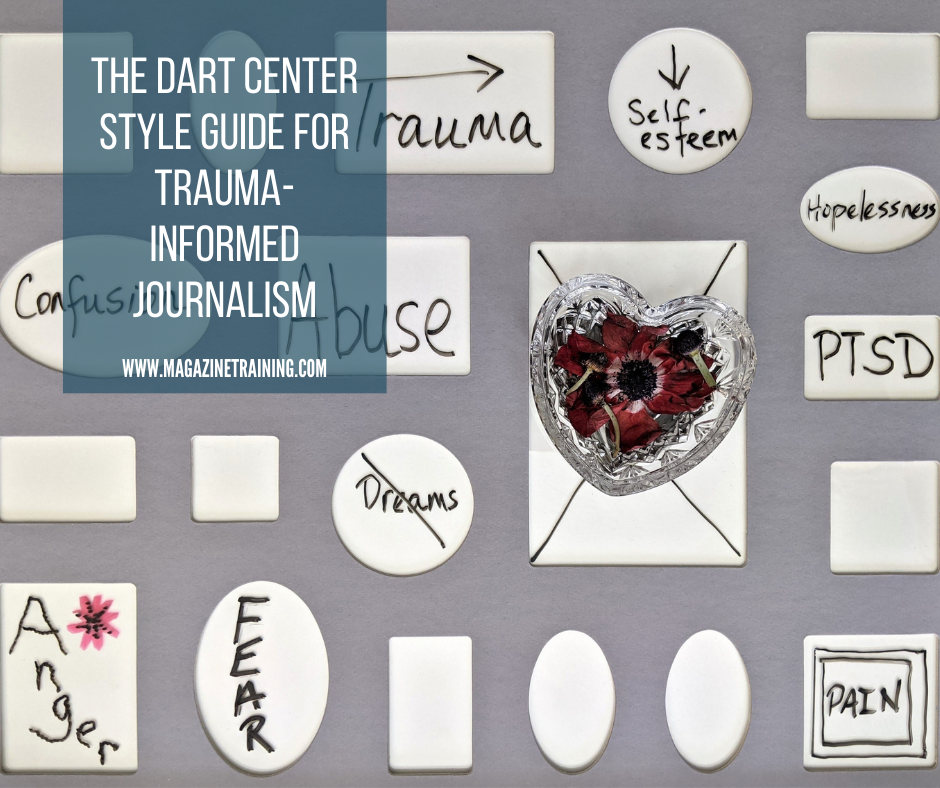
This style guide is designed as a quick, authoritative reference for reporters, editors and producers working on tight deadlines. It includes brief evidence-informed guidance on news choices, language usage and ethics in reporting on the impact of trauma on individuals, families and communities; recommendations for appropriate use of relevant psychological and scientific terminology; and special considerations when reporting on consequential trauma-laden issues such as racism and sexual violence.
Reporting on trauma is central to news. If you are a journalist reading these words, you already know it in your bones. Whether in breaking news or investigative reporting, local beats or international coverage, features or photographs: Knowledgeable and ethical reporting on violence, crisis and tragedy poses a profound daily challenge to craft and to the personal capacity of news professionals.
In recent years, journalists have forged significant innovations in how trauma is reported: fresh approaches to interviewing and source development, investigative method, storytelling, ethics and the news agenda itself. Many of these innovations are shaped by rapidly-evolving scientific understanding of the many ways violence, abuse, conflict and chronic threat affect brains, bodies and communities over time. Others are driven by evolving awareness of historic violence and the experiences of marginalized or vulnerable communities. The public itself is now talking about trauma more frequently, with deeper engagement. As a result, responsible reporting and newsroom decision-making now demand baseline literacy in trauma concepts and emerging reporting standards.
This concise style guide, compiled by Columbia University’s Dart Center for Journalism and Trauma with input from leading news professionals, clinicians and academic researchers, is designed as a quick, authoritative reference for reporters, editors and producers working on tight deadlines. It includes brief evidence-informed guidance on news choices, language usage and ethics in reporting on the impact of trauma on individuals, families and communities; recommendations for appropriate use of relevant psychological and scientific terminology; and special considerations when reporting on consequential trauma-laden issues such as racism and sexual violence.
All entries in this style guide reflect the Dart Center’s baseline recommendations for best practice. Entries rooted in trauma science are grounded in evidence-based consensus among experts, or define fundamental conceptual arguments and other areas of unresolved knowledge. Entries on reporting practices reflect the accumulated recommendations and expertise of Dart Center fellows, Dart Award winners and other journalists who have placed the careful, evidence-informed consideration of trauma at the center of their work.
While in some areas of usage our guidance is stringent (for instance, the limited circumstances in which it is accurate to refer to Post Traumatic Stress Disorder), in most cases we have emphasized guidelines and recommendations over rigid commandments, recognizing the fluid, complex and assignment-specific nature of journalistic decision-making. We aim for trauma-informed critical thinking in journalists, not inflexible adherence.
The Dart Center Style Guide is a living document, designed to be regularly expanded and updated to reflect evolving best practices, innovations in news coverage and growing scientific understanding. It is also a gateway to additional resources for journalists seeking to explore trauma journalism in greater depth. Entries link to the Dart Center’s extensive online library of tip sheets, backgrounders and journalist-to-journalist guidance, and as well as other authoritative resources.
Any journalism stylebook is necessarily a reflection of time, place and culture. Trauma study, too, is a field in which culture and identity are never neutral. Though this style guide attempts wherever possible to reflect global, cross-cultural and intersectional perspectives, its authors are Anglophone journalists and researchers affiliated with a U.S. university, steeped in the norms and perspectives of American and English-language news professionals and clinicians. We welcome any feedback, suggestions and criticism that can enrich the Dart style guide’s relevance to the global community of journalists.
The Dart Style Guide was originally compiled in 2020-2021 by Resources Editor Isobel Thompson. Initial entries were vetted, expanded and edited by the Dart Center’s executive director, research director and global staff. Entries were reviewed with a wider advisory group of journalists and clinicians. Please let us know what guidance you find useful, what you disagree with and what’s missing. Send comments to [email protected].
USING THIS GUIDE
The Dart Center Style Guide is organized in four thematic sections:
Trauma Science and Psychology, which provides guidance on terms and issues such as PTSD, Moral Injury and Vicarious Trauma.
Violence and Aftermath, which includes entries on themes such as gun violence, conflict and sexual violence.
Identity, which focuses on themes such as age, disability and gender identity.
Community and Social Issues, which offers guidance on topics such as migration, death and human trafficking.
Entries within each section are alphabetical. Entries also include links to related in-depth resources.
For convenience in searching, the Style Guide is posted as a single document. For rapid reference on a particular term (i.e. Complex PTSD) or issue (i.e. childhood trauma) use your browser’s FIND function.
By Bruce Shapiro, Dart Center
Photo by Susan Wilkinson on Unsplash
Related posts
Magazine Training International’s mission is to encourage, strengthen, and provide training and resources to Christian magazine publishers as they seek to build the church and reach their societies for Christ.

